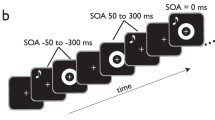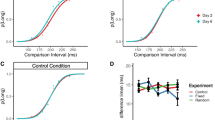Abstract
There has been a growing interest in developing behavioral tasks to enhance temporal acuity as recent findings have demonstrated changes in temporal processing in a number of clinical conditions. Prior research has demonstrated that perceptual training can enhance temporal acuity both within and across different sensory modalities. Although certain forms of unisensory perceptual learning have been shown to be dependent upon task difficulty, this relationship has not been explored for multisensory learning. The present study sought to determine the effects of task difficulty on multisensory perceptual learning. Prior to and following a single training session, participants completed a simultaneity judgment (SJ) task, which required them to judge whether a visual stimulus (flash) and auditory stimulus (beep) presented in synchrony or at various stimulus onset asynchronies (SOAs) occurred synchronously or asynchronously. During the training session, participants completed the same SJ task but received feedback regarding the accuracy of their responses. Participants were randomly assigned to one of three levels of difficulty during training: easy, moderate, and hard, which were distinguished based on the SOAs used during training. We report that only the most difficult (i.e., hard) training protocol enhanced temporal acuity. We conclude that perceptual training protocols for enhancing multisensory temporal acuity may be optimized by employing audiovisual stimuli for which it is difficult to discriminate temporal synchrony from asynchrony.



Similar content being viewed by others
References
Ahissar M, Hochstein S (1997) Task difficulty and the specificity of perceptual learning. Nature 387:401–406
Ahissar M, Hochstein S (2004) The reverse hierarchy theory of visual perceptual learning. Trends Cognit Sci 8:457–464
Anguera JA, Boccanfuso J, Rintoul JL et al (2013) Video game training enhances cognitive control in older adults. Nature 501:97–101
Brainard DH (1997) The psychophysics toolbox. Spat Vis 10:433–436
Chen Y-C, Shore DI, Lewis TL, Maurer D (2016) The development of the perception of audiovisual simultaneity. J Exp Child Psychol 146:17–33
DeLoss DJ, Watanabe T, Andersen GJ (2014) Optimization of perceptual learning: Effects of task difficulty and external noise in older adults. Vision Res 99:37–45
Deveau J, Ozer DJ, Seitz AR (2014) Improved vision and on-field performance in baseball through perceptual learning. Curr Biol 24:R146–R147
Diederich A, Colonius H (2004) Bimodal and trimodal multisensory enhancement: effects of stimulus onset and intensity on reaction time. Percept Psychophys 66:1388–1404
Dixon NF, Spitz L (1980) The detection of auditory visual desynchrony. Perception 9:719–721
Fujisaki W, Shimojo S, Kashino M, Sy Nishida (2004) Recalibration of audiovisual simultaneity. Nat Neurosci 7:773–778
Hillock AR, Powers AR, Wallace MT (2011) Binding of sights and sounds: age-related changes in multisensory temporal processing. Neuropsychologia 49:461–467. doi:10.1016/j.neuropsychologia.2010.11.041
Hillock-Dunn A, Wallace MT (2012) Developmental changes in the multisensory temporal binding window persist into adolescence. Dev Sci 15:688–696
Law C-T, Gold JI (2008) Neural correlates of perceptual learning in a sensory-motor, but not a sensory, cortical area. Nat Neurosci 11:505–513. doi:10.1038/nn2070
Law CT, Gold JI (2010) Shared mechanisms of perceptual learning and decision making. Top Cognit Sci 2:226–238
Meredith MA, Nemitz JW, Stein BE (1987) Determinants of multisensory integration in superior colliculus neurons. I. Temporal factors. J Neurosci 7:3215–3229
Mishra J, Gazzaley A (2014) Harnessing the neuroplastic potential of the human brain & the future of cognitive rehabilitation. Front Hum Neurosci 8:218
Mishra J, de Villers-Sidani E, Merzenich M, Gazzaley A (2014) Adaptive training diminishes distractibility in aging across species. Neuron 84:1091–1103
Mishra J, Anguera JA, Gazzaley A (2016) Video games for neuro-cognitive optimization. Neuron 90:214–218
Navarra J, Vatakis A, Zampini M, Soto-Faraco S, Humphreys W, Spence C (2005) Exposure to asynchronous audiovisual speech extends the temporal window for audiovisual integration. Cogn Brain Res 25:499–507
Navarra J, Soto-Faraco S, Spence C (2007) Adaptation to audiotactile asynchrony. Neurosci Lett 413:72–76
Noel J-P, Łukowska M, Wallace M, Serino A (2016) Multisensory simultaneity judgment and proximity to the body. J Vis 16:1–17
Pelli DG (1997) The VideoToolbox software for visual psychophysics: transforming numbers into movies. Spat Vis 10:437–442
Powers AR, Hillock AR, Wallace MT (2009) Perceptual training narrows the temporal window of multisensory binding. J Neurosci 29:12265–12274
Powers AR, Hevey MA, Wallace MT (2012) Neural correlates of multisensory perceptual learning. J Neurosci 32:6263–6274
Powers AR III, Hillock-Dunn A, Wallace MT (2016) Generalization of multisensory perceptual learning. Sci Rep 6:23374
Seitz AR, Dinse HR (2007) A common framework for perceptual learning. Curr Opin Neurobiol 17:148–153
Seitz AR, Nanez JE Sr, Holloway S, Tsushima Y, Watanabe T (2006) Two cases requiring external reinforcement in perceptual learning. J Vis 6:966–973. doi:10.1167/6.9.9
Setti A, Stapleton J, Leahy D, Walsh C, Kenny RA, Newell FN (2014) Improving the efficiency of multisensory integration in older adults: audio-visual temporal discrimination training reduces susceptibility to the sound-induced flash illusion. Neuropsychologia 61:259–268
Stein BE, Stanford TR (2008) Multisensory integration: current issues from the perspective of the single neuron. Nat Rev Neurosci 9:255–266
Stein BE, Stanford TR, Rowland BA (2014) Development of multisensory integration from the perspective of the individual neuron. Nat Rev Neurosci 15:520–535
Stevenson RA, Wallace MT (2013) Multisensory temporal integration: task and stimulus dependencies. Exp Brain Res 227:249–261. doi:10.1007/s00221-013-3507-3
Stevenson RA, Zemtsov RK, Wallace MT (2012) Individual differences in the multisensory temporal binding window predict susceptibility to audiovisual illusions. J Exp Psychol Hum Percept Perform 38:1517–1529. doi:10.1037/a0027339
Stevenson RA, Wilson MM, Powers AR, Wallace MT (2013) The effects of visual training on multisensory temporal processing. Exp Brain Res 225:479–489. doi:10.1007/s00221-012-3387-y
Stevenson RA, Siemann JK, Schneider BC, Eberly HE, Woynaroski TG, Camarata SM, Wallace MT (2014) Multisensory temporal integration in autism spectrum disorders. J Neurosci 34:691–697
Sumby WH, Pollack I (1954) Visual contribution to speech intelligibility in noise. J Acoust Soc Am 26:212–215
Van der Burg E, Alais D, Cass J (2013) Rapid recalibration to audiovisual asynchrony. J Neurosci 33:14633–14637. doi:10.1523/jneurosci.1182-13.2013
Van der Burg E, Alais D, Cass J (2015a) Audiovisual temporal recalibration occurs independently at two different time scales. Sci Rep 5:1–7
Van der Burg E, Orchard-Mills E, Alais D (2015b) Rapid temporal recalibration is unique to audiovisual stimuli. Exp Brain Res 233:53–59
Van Eijk RL, Kohlrausch A, Juola JF, van de Par S (2008) Audiovisual synchrony and temporal order judgments: effects of experimental method and stimulus type. Percept Psychophys 70:955–968
Vroomen J, Keetels M (2010) Perception of intersensory synchrony: a tutorial review. Atten Percept Psychophys 72:871–884
Vroomen J, Keetels M, De Gelder B, Bertelson P (2004) Recalibration of temporal order perception by exposure to audio-visual asynchrony. Cogn Brain Res 22:32–35
Wallace MT, Stevenson RA (2014) The construct of the multisensory temporal binding window and its dysregulation in developmental disabilities. Neuropsychologia 64:105–123
Wang Y, Song Y, Qu Z, Ding Y (2010) Task difficulty modulates electrophysiological correlates of perceptual learning. Int J Psychophysiol 75:234–240
Acknowledgments
The project was supported by NIH grants CA183492 and HD083211, the Simons Foundation Autism Research Initiative, and the Wallace Foundation. The authors have no conflicts of interest to declare.
Author information
Authors and Affiliations
Corresponding author
Rights and permissions
About this article
Cite this article
De Niear, M.A., Koo, B. & Wallace, M.T. Multisensory perceptual learning is dependent upon task difficulty. Exp Brain Res 234, 3269–3277 (2016). https://doi.org/10.1007/s00221-016-4724-3
Received:
Accepted:
Published:
Issue Date:
DOI: https://doi.org/10.1007/s00221-016-4724-3




